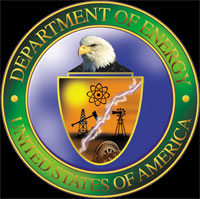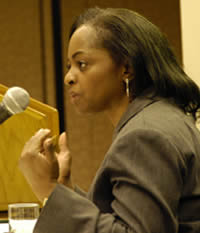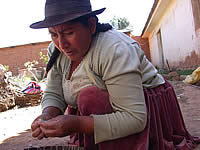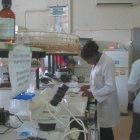WASHINGTON DC -- The Administration will be presenting its FY'08 budget recommendations for all federal programs, including DOE, on Monday - February 5.

This list provides a summary of those 2008 funding levels being proposed. The budgets by various sustainable energy advocacy organizations represent renewable energy and energy efficiency technology programs in the
U.S. Department of Energy (DOE).
The organizations include:
1.) Biomass Coordinating Council
2.) Geothermal Energy Association
3.) National Hydropower Association
4.) Solar Energy Industries Association
5.) American Wind Energy Association
6.) American Public Power Association
7.) The Stella Group, Ltd.
8.) Solena Group, Inc.
9.) American Council for an Energy-Efficient Economy
10.) Alliance to Save Energy
11.) U.S. Combined Heat and Power Association
12.) Breakthrough Technologies Institute (and National Hydrogen
Association)
13.) National Association of State Energy Officials
Each of the budget recommendations presented below represents the position
of only the individual organization proposing them.
For further information on the justification for the proposed budget
numbers or for details on how the funds could best be spent within each
program account, please contact the corresponding organization.
I.) Biomass Coordinating Council:: BIOFUELS: $700.0 Million
Expanded RDD$D for cellulosic programs and biorefinery grants and loan
guarantee programs
BIOPOWER: $100.0 Million
For technologies to support biofuels plants, government facilities and
public institutions to reduce use of fossil fuels.
CONTACT: William Holmberg, Biomass Coordinating Council, 1629 "K" St.,
NW; Suite 210; Washington DC 20006 202-393-0001, x.7588;
biorefiner@aol.com
II.) Geothermal Energy Association::GEOTHERMAL: $75.0 Million
This is consistent with the Energy Policy Act of 2005's directive that
"The Secretary shall conduct a program of research, development,
demonstration, and commercial application for geothermal energy..."
CONTACT: Karl Gawell, Geothermal Energy Association, 209 Pennsylvania
Avenue, S.E.; 2nd floor; Washington, D.C. 20003; 202-454-5264;
karl@geo-energy.org
III.) National Hydropower Association::HYDROPOWER: $12.0 Million
To encourage the development and deployment of new emerging hydropower
technologies - ocean wave, tidal and in-stream hydrokinetic - and to
increase capacity at existing facilities through the development and
installation of the "next generation" of hydropower equipment.
CONTACT: Jeff Leahey, National Hydropower Association, 1 Massachusetts
Avenue, N.W.; Suite #850; Washington, D.C. 20001; 202-682-1700;
jeff@hydro.orgIV.) Solar Energy Industries Association::SOLAR PHOTOVOLTAICS: $175.0 Million
CONCENTRATING SOLAR POWER: $25.0 Million
SOLAR HEATING AND LIGHTING: $10.0 Million
To fund the President's Solar America Initiative, a major new R&D
initiative to achieve cost-competitive solar energy technologies across
all market sectors by 2015.
CONTACT: Noah Kaye, Director of Public Affairs, Solar Energy Industries
Association (SEIA); 805 15th Street NW, Suite 510, Washington, DC 20005;
202-682-0556;
nkaye@seia.orgV.) American Wind Energy Association::WIND POWER TECHNOLOGIES: $110.0 Million
Funding would be focused on developing next-generation large wind turbines
as well as research and development for next-generation small wind
turbines.
CONTACT: Bree A. Raum, American Wind Energy Association, 1101 14th
Street, N.W.; 12th floor; Washington, D.C. 20005202-383-2513;
braum@awea.orgVI.) American Public Power Association: :
RENEWABLE ENERGY PRODUCTION INCENTIVE: $80.0 Million
This would fully fund all past and current REPI applicants.
CONTACT: Claude P. Boudrias, American Public Power Association, 2301 "M"
Street, NW Washington, DC 20037; 202-467-2929;
cboudrias@appanet.orgVII.) The Stella Group, Ltd.::
SMALL WIND TECHNOLOGIES: $7.0 Million
A sub-account within the wind budget.
MODULAR BIOMASS: $7.5 Million
A sub-account within the biomass budget
CONCENTRATED SOLAR POWER: $35.0 Million
A sub-account within the solar budget
SOLAR BUILDINGS: $10.0 Million
A sub-account within the solar budget
MISCELLANEOUS WATER POWER TECHNOLOGIES: $15.0 Million
For technology validation of free-flow hydropower, tidal, wave and ocean
current technologies to be cost-shared by State and local government RD&D
programs
CONTACT: Scott Sklar, The Stella Group, Ltd; 1616 "H" Street, N.W.; 10th
floor; Washington, D.C. 20006-4999; 202-347-2214;
solarsklar@aol.comVIII.) Solena Group, Inc. ::
BIOMASS-TO-SYNGAS PRODUCTION: $100.0 Million
For loan guarantees for plants gasifying biomass and agricultural wastes
to produce a syngas that can be used in combined cycle to produce
renewable power. This would be a sub-account of the biomass program.
CONTACT: Dennis F. Miller (Chief Scientist and Vice President); Solena
Group, Inc.; 1900 "K" Street, N.W.; Washington, D.C. 20006; 202-682-2405;
Dmiller@solenagroup.comIX.) American Council for an Energy-Efficient Economy::VEHICLE TECHNOLOGIES - ENERGY EFFICIENCY RD&D: $200.0 Million
With emphasis on advanced materials, hybrid propulsion, and heavy vehicle
systems.
BUILDINGS TECHNOLOGIES - ENERGY EFFICIENCY RD&D: $85.0 Million
With emphasis on appliance standards, emerging technologies, commercial
building integration, and residential building integration
INDUSTRIAL TECHNOLOGIES - ENERGY EFFICIENCY RD&D: $75.0 Million
To support sector-specific and cross-cutting RD&D programs.
CONTACT: Bill Prindle (Acting Executive Director), American Council for
an Energy Efficient Economy, 1101 Connecticut Avenue, N.W.; #801;
Washington, D.C. 20036; 202-429-8873 x.710;
bprindle@aceee.orgX.) Alliance to Save Energy::ENERGY EFFICIENCY R&D AND DEPLOYMENT PROGRAMS: $865.0 Million
Note: This figure does not include the additional funding needed by the
State Energy Program and Weatherization accounts (see NASEO
recommendations further down).
APPLIANCE STANDARDS: $20.0 million
FEDERAL ENERGY MANAGEMENT PROGRAM: $30.0 Million
CONTACT: Lowell Ungar, Alliance to Save Energy, 1850 "M" Street N.W.;
Suite 600; Washington, DC 20036; 202-530-2236;
lungar@ase.orgXI.) U.S. Combined Heat and Power Association::
DISTRIBUTED ENERGY PROGRAM: $60.6 Million
This is consistent with the 2006 authorized level (the Energy Policy Act
of 2005 includes authorization of $730 million for DE over the next three
years). Also shift of major program elements back to the Office of Energy
Efficiency and Renewable Energy from Office of Electricity Delivery and
Energy Reliability.
CONTACT: Paul Bautista, U.S. Combined Heat and Power Association; 5004
Fort Sumner Drive; Bethesda, MD 20816; 301-320-2505;
paul.bautista@comcast.netXII.) Breakthrough Technologies Institute (and the National Hydrogen
Association) ::
FUEL CELL AND RELATED HYDROGEN RESEARCH: $555.0 Million
This would bring the program up to the 2006 authorized level (EPAct'05
authorized level for 2008 is $739.5 million for EERE and Science, but not
nuclear and FutureGen).
CONTACT: Bob Rose, Breakthrough Technologies Institute, 1100 "H" Street,
N.W.; Suite 800; Washington, DC 20006-5482; 202-785-4222, ext. 11;
brose@fuelcells.organd/or
Jerry Hinkle (Vice President for Policy and Government Affairs), National
Hydrogen Association, 1800 "M" St N.W.; Suite 300 North; Washington, DC
20036-5802; 202-261-1307;
HinkleJ@HydrogenAssociation.orgXIII.) National Association of State Energy Officials::STATE ENERGY PROGRAM: $80.0 Million
The FY'07 authorized level is $100 million.
WEATHERIZATION: $300.0 Million
The authorized level is $600 million.
CONTACT: Jeff Genzer (General Counsel), National Association of State
Energy Officials, c/o Duncan, Weinberg, Genzer & Pembroke, P.C.; 1615 "M"
Street, N.W.; Suite 800; Washington, D.C. 20036; 202-467-6370;
JCG@dwgp.comGreener News Room
 In Jackson, Mississippi, a red state in the heart of the bible belt, the battle over abortion was kicked into high gear when an eight day anti-abortion demonstration ensued in the state's capital this past summer. On one side: activists fighting to save the last abortion clinic in the state. On the other: Operation Save America trying to shut it down.
In Jackson, Mississippi, a red state in the heart of the bible belt, the battle over abortion was kicked into high gear when an eight day anti-abortion demonstration ensued in the state's capital this past summer. On one side: activists fighting to save the last abortion clinic in the state. On the other: Operation Save America trying to shut it down.











 International Polar Year is a global research effort to better understand the polar regions and their climatic effect on the Earth. More than 200 scientific expeditions will take place over the next two years to study changes to permafrost, the melting of polar ice sheets, and marine life in the cold and dark. The research completed during IPY will provide a baseline for understanding future environmental change.
International Polar Year is a global research effort to better understand the polar regions and their climatic effect on the Earth. More than 200 scientific expeditions will take place over the next two years to study changes to permafrost, the melting of polar ice sheets, and marine life in the cold and dark. The research completed during IPY will provide a baseline for understanding future environmental change.

 When slave Dred Scott and his wife Harriet arrived in St. Louis, Missouri in the spring of 1846, they came as refugees in their own land and they must have been overwhelmed by the willingness of white St. Louisans to accept them as free Americans.
When slave Dred Scott and his wife Harriet arrived in St. Louis, Missouri in the spring of 1846, they came as refugees in their own land and they must have been overwhelmed by the willingness of white St. Louisans to accept them as free Americans.



 Slovic is studying the issue from a psychological perspective, trying to determine how people can utilize both the moral intuition that genocide is wrong and moral reasoning to reach not only an outcry but also demand intervention. “We have to understand what it is in our makeup – psychologically, socially, politically and institutionally – that has allowed genocide to go unabated for a century,” he said. “If we don’t answer that question and use the answer to change things, we will see another century of horrible atrocities around the world.”
Slovic is studying the issue from a psychological perspective, trying to determine how people can utilize both the moral intuition that genocide is wrong and moral reasoning to reach not only an outcry but also demand intervention. “We have to understand what it is in our makeup – psychologically, socially, politically and institutionally – that has allowed genocide to go unabated for a century,” he said. “If we don’t answer that question and use the answer to change things, we will see another century of horrible atrocities around the world.” Cholera is a severe intestinal disease caused by the bacteria Vibrio cholerae. It causes severe diarrhoea and can lead to death within 24 hours if left untreated. Contaminated drinking water and poor sanitation are common causes of infection.
Cholera is a severe intestinal disease caused by the bacteria Vibrio cholerae. It causes severe diarrhoea and can lead to death within 24 hours if left untreated. Contaminated drinking water and poor sanitation are common causes of infection.
 One of the true ironies of the American civil rights movement is that while the U.S. was trying to lead the way in developing a framework for international human rights, it was leaving its own citizens behind, refusing to acknowledge the systematic social abandonment of African Americans.
One of the true ironies of the American civil rights movement is that while the U.S. was trying to lead the way in developing a framework for international human rights, it was leaving its own citizens behind, refusing to acknowledge the systematic social abandonment of African Americans.



 This list provides a summary of those 2008 funding levels being proposed. The budgets by various sustainable energy advocacy organizations represent renewable energy and energy efficiency technology programs in the
This list provides a summary of those 2008 funding levels being proposed. The budgets by various sustainable energy advocacy organizations represent renewable energy and energy efficiency technology programs in the 





